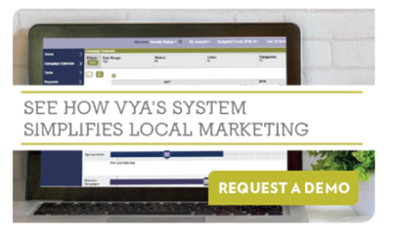 As you may have heard, Direct Options recently became part of the Vya family. This gives us the opportunity to share our customer data management and analytics experience and knowledge with the growing community of Vya friends and followers. I am thrilled to be able to kick off this knowledge sharing with some thoughts on what I believe is the essential element of any data-driven marketing strategy: usable data.
As you may have heard, Direct Options recently became part of the Vya family. This gives us the opportunity to share our customer data management and analytics experience and knowledge with the growing community of Vya friends and followers. I am thrilled to be able to kick off this knowledge sharing with some thoughts on what I believe is the essential element of any data-driven marketing strategy: usable data.
Usable data enables businesses to access their customer intelligence more quickly, provide better insights, and market more effectively. But what happens when that data isn’t clean, accurate and easy to interpret? According to Gartner, poor data costs businesses an average of $15 million annually, related to lost revenue opportunities, deficient customer experiences and lack of compliance with government regulations.
In fact, it’s more common than not for companies to have deficient data. Data disconnects between departments, data silos, and varied approaches to organizing data are all contributors to sub-optimum data. When data is not housed centrally or organized, a company may not know which of its customers are participating in particular product or service offerings. This can lead to serving contacts irrelevant information and directing marketing dollars to the wrong place.
To imagine the advantages of usable data, take a critical look at how data is spread out, sorted and used in different ways across your organization. Start by asking yourself a few key questions related to how data can support your customer marketing, strategic and financial objectives.
|
CUSTOMER MARKETING
|
STRATEGIC
|
FINANCIAL
|
Making Data Usable
Data is made usable by gathering customer data sets from a variety of sources – internal and external – and putting them into a standardized format to create a data warehouse. Once the data warehouse is complete, the data can be easily accessed or analyzed to make informed decisions.
Depending on your company’s available resources, it may make sense to outsource the building of a data warehouse to a trusted vendor. A quality vendor should be able to take your data in any combination of formats. They can standardize it and perform analysis, such as segmentation, profiling, modeling and predictive analytics.
Sometimes organizations will go through the process of cleaning and organizing their data, only to put it in a drawer so to speak, where data decay starts all over again. This is where visualizing data comes into play – optimizing your data for easy access and use.
A marketing database that can serve up visualized data, through charts and graphs via a dashboard makes it faster and easier to extract insights to drive your marketing decisions and campaigns. For example, a marketer knows there are certain products and services that are suitable for certain customers. If data is visualized, that marketer can easily see the best offerings for a specific customer and apply the right offer, via the right channel, at the right time.
Whether you are maintaining your data internally or with help from a knowledgeable vendor, it’s important that your organization does not revert to its old ways of data management. You can guard against this by building in periodic reviews to level set and revisit recommendations for achieving and maintaining the most usable data possible.
Analyzing Usable Data to Drive Smarter Marketing
Once you’ve done the work of building a data warehouse and organizing and visualizing your data for usability, it’s time to make it work for you with actionable data analysis. The types of data that can be analyzed to drive smarter marketing programs and strategies include customer name, address, transaction history, billing information, participation in other programs or services, demographic data and other third-party information and customer survey results, among others.
By analyzing your usable data, you can design smarter marketing campaigns by better determining who should be contacted, who should not be contacted, how to contact, and what message or offer to send. You can also conduct mid-campaign analysis to see how the campaign is performing and if anything needs to be adjusted.
With usable data at your fingertips, you can also conduct customer insight surveys that incorporate psychographics, enabling you to classify customers according to their attitudes, aspirations, and other psychological criteria. This can help you create a model for identifying your best customers for a particular product or service. In addition, if you apply emotional drivers to your survey and analysis, you can determine the best message to deliver once you’ve determined the best product or service.
For example, one of our clients in the energy industry analyzed its customers who enrolled in a fixed-rate billing program. The primary goal of the analysis was to determine how to maximize the same offer the following year. In its initial fixed-rate billing campaign, the company used the phrase “peace of mind” in its messaging around the assurance that bills would not increase each month. However, after surveying customers about their motivations for participating in the program, they learned that the more definitive word “knowing” bills would not increase monthly was driving their decision to participate. This allowed our client to test messaging around enrollment drivers and better predict how the campaign would perform the following year.
In this same way, it’s helpful to conduct customer satisfaction studies pre- and post-measurement to understand the impact on customer satisfaction of products and services, and what the drivers of satisfaction are.
Usable Data’s Role In the 2020 Economy
During the dynamic market conditions of 2020 and looking to the year ahead, marketers need to consider how best to maximize their marketing dollars, using the most cost-effective channels to achieve the best results. In this environment, usable data is vital to ensuring they are targeting the right customer with the right message at the right time via the right channel.
Some of our clients have adjusted their messaging to reflect the current environment. It’s hard to confirm definitively at this point whether the environment or messaging is impacting response rates, but this is something we are watching and will be able to report on when there is more activity to measure.
Among the things we can examine, for example, is that with more customers and prospects working from home, are they paying attention more to their mail and email? If we can answer questions like this, then we can better determine the threats and opportunities for organizations going forward.
There is an opportunity to apply usable data and analysis to engage and increase business with existing customers. And further, you can use that data to find more customers that match your existing customers.
The good news is that with more and more customers using digital channels for service (e.g., restaurant apps, online banking, appointment scheduling apps) companies have more customer data than ever to analyze and use strategically. There could not be a better time to assess the usability of your data to put your business in the strongest position possible in the months and years ahead.



